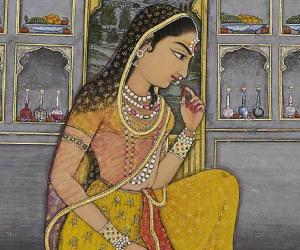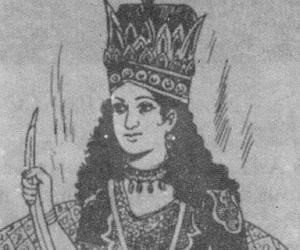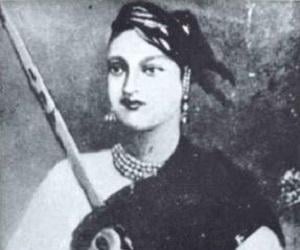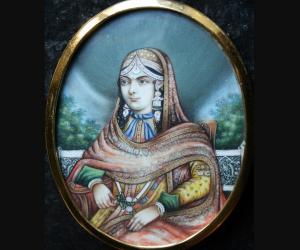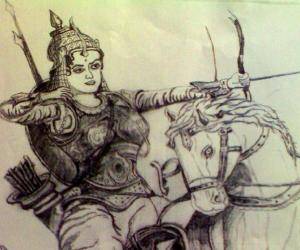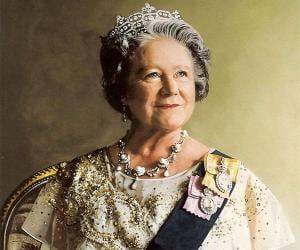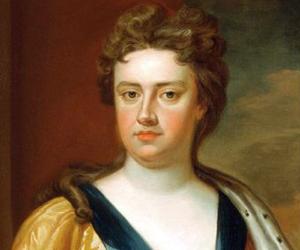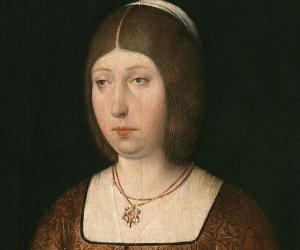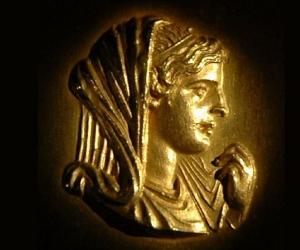The Legend of Padmini
The earliest literary work to mention Rani Padmini by name is ‘Padmavat’, an epic poem written by Indian poet Malik Muhammad Jayasi in 1540 CE. According to this version of the story, Padmavati was the daughter of Gandharv Sen, the king of the Singhal kingdom (Sri Lanka).
She owned a talking parrot named Hiraman, but her father, who disliked her obsession with the bird, had ordered it to be killed. While the bird was able to fly away and save its life, it later fell into the hands of a bird catcher who sold it to a Brahmin.
Once the Brahmin brought the bird to Chittor, impressed by its ability to talk, the local king Ratan Sen purchased it from him. The parrot incessantly praised Padmavati’s heavenly beauty, which enamored the king who decided to embark on a quest to marry the princess.
The bird guided Ratan Sen and his 16,000 followers to Singhal, which they reached after crossing the seven seas. The king began ‘Tapasya’ in a temple which Padmavati visited after being informed by the parrot, but she left the temple without visiting him and regretted her decision once back in the palace.
Ratan Sen, who was about to immolate himself after learning that he missed the chance to meet the princess, was stopped by deities Shiva and Parvati who advised him to attack the royal fortress. He and his followers, still dressed as ascetics, were defeated and imprisoned, but as the king was about to be executed, his loyal bard revealed that he was the king of Chittor.
Gandharv Sen agreed to marry Padmavati to Ratan Sen and also arranged 16,000 ‘padmini’ (most desirable) women for his companions. As he began the return journey, the Ocean god created a devastating storm to punish him for his arrogance in winning over the most beautiful woman in the world.
Only Ratan Sen and Padmavati survived the storm, but were separated, during which time the daughter of the Ocean god, Lacchmi, appeared before the king disguised as Padmavati to test his love for her. After he passed the test, the Ocean god and his daughter united them and rewarded them with gifts.
As they finally reached Chittor, Ratan Sen, who was already married to Nagmati, witnessed a rivalry between his two wives. Soon after, one of his courtiers, Raghav Chetan, who was banished for fraud, reached the court of the Sultan of Delhi, Alauddin Khalji, and described Padmavati’s exceptional beauty.
Determined to obtain Padmavati, Khalji laid siege on Chittor, but when Ratan Sen offered him tribute to save his wife, he captured him by deceit after feigning a peace treaty. At Padmavati’s behest, Ratan Sen's loyal feudatories Gora and Badal reached Delhi dressed as Padmavati and her companions to free him, and while Gora was killed in a fight, Badal escorted Ratan Sen back to Chittor.
While Ratan Sen was imprisoned, a neighboring Rajput king, Devpal had made advances to Padmavati. When Ratan Sen returned to Chittor, he decided to punish Devpal for his misdemeanor. This resulted in a single combat duel between Ratan Sen and Devpal during which they killed each other.
In the meantime, Alauddin Khalji invaded Chittor again, following which Nagmati and Padmavati committed self-immolation (sati) on Ratan Sen's funeral pyre, with the other women of the fort committing mass self-immolation (jauhar) to save their honor.
Continue Reading Below
Other Versions
The popularity of Malik Muhammad Jayasi’s account of Padmavati has sprouted many alternative versions of the story since the late sixteenth century. Among these versions, Hemratan's ‘Gora Badal Padmini Chaupai’ (c.1589 CE) is unique in that it was the first account of the story that claimed to be based on a “true tale”.
Many Rajput rulers of Rajasthan subsequently sponsored various retellings of the legend in the 16th to 18th century. These versions shifted focus from Jayasi's theme of courting and marriage to the pride of defending the Rajput honor while under attack from Muslim ruler Alauddin Khalji.
At least 12 Persian and Urdu translations or adaptations of Jayasi's ‘Padmavat’ have been recorded between 16th to 19th centuries. Many more versions have been written in the recent times, most of which follow the love poetry tradition of the original poet.
The British writer James Tod’s ‘Annals and Antiquities of Rajasthan’ (1829) states that Padmini, the daughter of Hamir Sank of Ceylon, was married to Bhim Singh, the uncle of Lachhman Singh, the ruler of Chittor. According to this account, which has since been branded as unreliable, Gora and Badal were Rani Padmini’s relatives from Ceylon, and Khalji had demanded to see her through a mirror.
Tod’s version inspired many adaptations in regional languages, especially in Bengali, which generally followed the Rajput narrative of the Hindu queen Padmavati immolating herself to protect her honor against a Muslim invader. Among these were Yagneshwar Bandyopadhyay's ‘Mewar’ (1884), Kshirode Prasad Vidyavinode's play ‘Padmini’ (1906) and Abanindranath Tagore's ‘Rajkahini’ (1909).
Facts About Rani Padmini
Rani Padmini was known for her exceptional beauty, with poets and artists of the time often describing her as ethereal and captivating.
She was also renowned for her intelligence and courage, playing a key role in the defense of her kingdom during times of conflict.
Rani Padmini was a skilled horse rider and archer, showcasing her prowess in both physical and mental endeavors.
She was a patron of the arts and literature, supporting the development of cultural pursuits in her kingdom.
Rani Padmini's legacy continues to inspire artists, writers, and filmmakers to this day, with many interpretations of her life and story being created across different mediums.
